|
|
|
kayaking the Strait of Juan de Fuca
Tuesday, June 23 2009
setting: east-central San Juan Island, Washington State
Gretchen and I aren't much for breakfast as an institution, and the place we were staying didn't provide one either. But we needed something in our stomachs before the hiking we'd be doing today, so we heated up some leftover Thai food we'd carried from Seattle. Gretchen also still had some leftover Mexican food from last night. If it is a meal, breakfast for us is just like any other. Chips and salsa or pizza or curry and rice, anything but a room full of greasy smoke rising above frying pans full of eggy slime.
Mossy the cat made an appearance as I sat in the sun drinking my coffee out in back this morning. But there were no eagles over the hay field. The farmer who'd been using a machine to turn over his hay yesterday (which helps it dry) had gone through and rolled it up into enormous cinnamon rolls, the kind that would mysteriously catch on fire back in the days of Big Fun.
We drove up to the northwest corner of San Juan Island, only three or four miles from the Canadian frontier, and walked around the coastal remains of English Camp, now a national park. English Camp is the British half of the peaceful international co-occupation of San Juan Island during the "Pig War" of the mid-19th Century, back when the frontier between British America and the United States had yet to be precisely established, and tensions had risen to the point where a pig was shot in anger. The Pig War was a nuclear-free cold war and looking back on it the whole thing looks comic. But the British had a military base here and their troops lived and even died here, doing all the things bored guys with guns do when they're a half a world away from home. These days there are a few buildings left and a few park employees handing out literature, but for the most part the park has reverted back to nature. There was a telescope outside one of the buildings and through it we could see an osprey nest, complete with an actual osprey that occasionally stuck his or head up over its rim.
We went on walk on a trail that took us through climax forest to the end of a spit of land. As we walked, Bald Eagles kept taking off and landing from the crowns of the trees ahead. An eagle is so big at that proximity that its outstretched wings briefly darken the sky.
The tide was out and people with buckets were hunting for clams in the intertidal swath, something park rules permit. Clams have always been a huge part of human life on San Juan Island; when white men first came they found huge middens of clam shells from thousands of years of Native American occupation. The natives themselves had been wiped out by one of white man's biggest allies: Smallpox.
The clams were easy to spot even when buried beneath the sand. Every now and then one would spit a stream of water into the air (a stream that could fly ten feet in some cases), briefly disclosing a location.
Next we climbed to the top of Young Hill, one of several relatively tall landforms on the island. Its top is only 650 feet above sealevel (roughly the elevation of our house back in Hurley), but that's a prominence that rises directly from the sea (back in Hurley, the "mountain" our house sits atop rises from the Esopus plain, which is 170 feet above sealevel). Parts of Young Hill are fairly clear of forest as one approaches the top, so the view to the west and southwest is spectacular. We could easily see Vancouver Island in British Columbia, as well as the high snow-covered peaky jumble of the Olympic Mountains in Washington's "thumb." I'm not used to seeing mountains with snow on them in the summer time, so I kept staring at them in wonder. As I said to Gretchen, I enjoy being in a place where I can see, spread out before me, geographical features normally only presentable in map form.
One of the many things I like about human civilization on an island is its inherently self-contained nature. Sure, you can ship things in and out if needed, but that's expensive and it's often easiest just to try to get by with some on-island implementation of whatever needs implementing. It forces a do-it-yourself attitude on a settlement that might otherwise rely on specialists from outside. This is particularly true of a school system or a fire department, sewage disposal, and most human services, but it could be true of electric power generation, vegetable, seafood, and dairy production, and even lumber. On the drive back from English Camp, we went along Roche Harbor Road, which provides a northwest corridor through what passes as the island's wine country. We stopped in at San Juan Vineyards to partake of a wine tasting. At $1/taste, it was guilt-free tasting. We did buy a bottle, though, of their cheapest white "table wine," which was sort of a Gewürztraminer. We also befriended the wine shop's extremely friendly (though somewhat child-hostile) cat.
Back in Friday Harbor, we were looking for a place to eat, preferably (for me) a place with French fries., But Friday Harbor is a strange place, a place where lots of businesses that would, in a mainland town in the middle of the afternoon, be open, here are closed. So we ended up in the Chinese restaurant called the China Pearl. The owner appeared to be Chinese, but there aren't a lot of Chinese on the island and he'd had to hire a Caucasian hippie chick to serve as a waitress. The food wasn't great but we were hungry and it was adequate.
After a little downtime back at the guesthouse (where I read a little of Zen and the Art... and dozed off for twenty minutes), we drove back up to the northwest to do our next activity: sea kayaking the Straight of Juan de Fuca. It was now about 6:00pm, but it was just past the solstice at this high latitude, so it wouldn't be getting dark until 10:00.
We ended up with a group of affable young men from Connecticut in their early 20s, led by a "naturalist" who was only eighteen. Still, we had fun out on the water and the Connecticut guys even informally inducted us into their "wolf pack."
Gretchen was in the front and I was in the back of our two-person kayak. This was a mistake because the person in the back had not one but two jobs, and I am perhaps the world's worst multitasker. While paddling, I also had to push pedals to control the rudder. But even after hours on the water, I didn't have the mojo down. I felt like Gerald Ford trying to walk and chew gum at the same time (or John McCain trying to avert a banking crisis and campaign for President at the same time).
Unfortunately, we didn't see any orcas while we were out in the Straight, but along the way we learned where the whiskey used to be hauled ashore back during Prohibition. And at the end while we paddled around the glassy waters of Snug Harbor waiting for a sunset that never came, we learned a little about the San Juan school system. There's a high school on the San Juan itself and elementary schools on the other islands. Teenagers on the other islands have to take the ferry to school. San Juan Island's graduating high school classes are typically only 50 students (that blew the minds of the affable Connecticut guys, but not me, whose high school class was only about 90 students). San Juan high school lacks a pool and a swimming team but it does have an AP biology program.
Before turning in for the night, I convinced Gretchen to go with me one last time into Friday Harbor so I could get some French fries and a India pale ale in my belly. We ended up at San Juan Brewing Company, which Gretchen found suspect because of its revolting "bacon-flavored beer." But they also make a great beer called Royal Marine India Pale Ale and Gretchen enjoyed her hard cider, which tasted to me like ginger ale. And their $5 plate of French fries was so enormous I couldn't finish it.

The Olympic Range of Washington State, as viewed from near the top of Young Hill. The landmasses in the midground are the Chatham Islands of British Columbia.
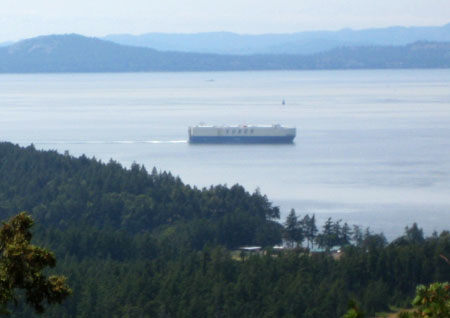
A northbound container ship in the Straight of Juan de Fuca, as viewed from near the top of Young Hill.
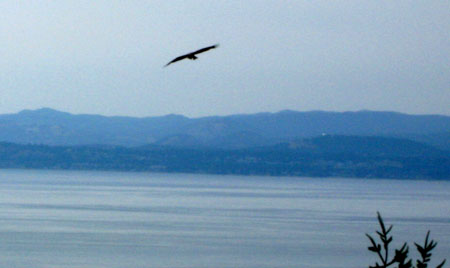
An eagle (though not an adult Bald Eagle) sores over the Straight of Juan de Fuca, as viewed from near the top of Young Hill.
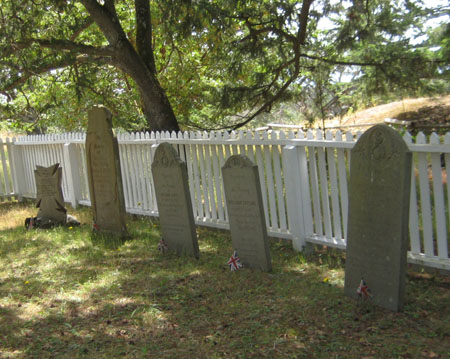
Graves at the well-tended English Camp Cemetary. All of these dead are British, killed for non-combat-related reasons common to any group of bored occupying soldiers. Their occupation was related to the "Pig War" between the British and Americans during the middle of the 19th Century, when the frontier through the San Juan Islands hadn't yet been established. The war's only casualty was a pig.

Gretchen on the trail leaving the English Camp Cemetary.
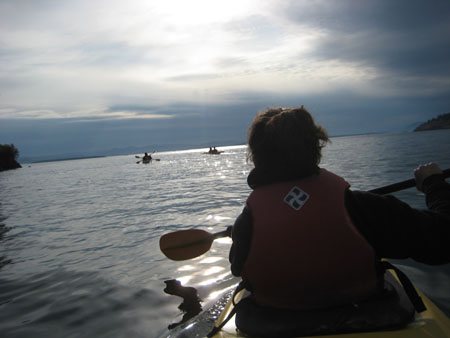
Gretchen paddling our kayak as we enter the Straight of Juan de Fuca.

The still-snowy Olympic mountains were visible to the southwest from our kayaking.
That nearby island posted with a sign is centered at 48.561063N, 123.178244W, well within American waters.

A guillemot. Vancouver Island, British Columbia, is visible in the background.
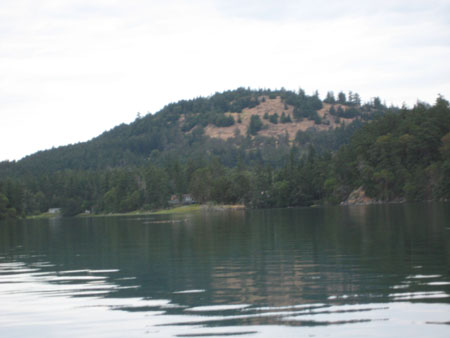
Young Hill, as viewed from Snug Harbor.

The young men with whom we kayacked from Snug Harbor on San Juan Island.

Me at San Juan Brewing Company with the remains of an India pale ale. The chair I was sitting on was far too low for the table, but here I'm also scrunched down from gluttony. Unseen is the enormous plate of fries I nearly finished.
For linking purposes this article's URL is:
http://asecular.com/blog.php?090623 feedback
previous | next |










